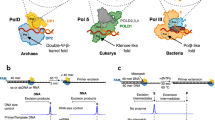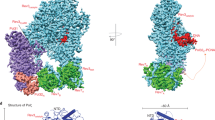Abstract
Translesion synthesis (TLS) by Y-family DNA polymerases is a chief mechanism of DNA damage tolerance1. Such TLS can be accurate or error-prone, as it is for bypass of a cyclobutane pyrimidine dimer by DNA polymerase η (XP-V or Rad30) or bypass of a (6-4) TT photoproduct by DNA polymerase V (UmuD′2C), respectively2,3. Although DinB is the only Y-family DNA polymerase conserved among all domains of life, the biological rationale for this striking conservation has remained enigmatic4. Here we report that the Escherichia coli dinB gene is required for resistance to some DNA-damaging agents that form adducts at the N2-position of deoxyguanosine (dG). We show that DinB (DNA polymerase IV) catalyses accurate TLS over one such N2-dG adduct (N2-furfuryl-dG), and that DinB and its mammalian orthologue, DNA polymerase κ, insert deoxycytidine (dC) opposite N2-furfuryl-dG with 10–15-fold greater catalytic proficiency than opposite undamaged dG. We also show that mutating a single amino acid, the ‘steric gate’ residue of DinB (Phe13 → Val) and that of its archaeal homologue Dbh (Phe12 → Ala), separates the abilities of these enzymes to perform TLS over N2-dG adducts from their abilities to replicate an undamaged template. We propose that DinB and its orthologues are specialized to catalyse relatively accurate TLS over some N2-dG adducts that are ubiquitous in nature, that lesion bypass occurs more efficiently than synthesis on undamaged DNA, and that this specificity may be achieved at least in part through a lesion-induced conformational change.
This is a preview of subscription content, access via your institution
Access options
Subscribe to this journal
Receive 51 print issues and online access
$199.00 per year
only $3.90 per issue
Buy this article
- Purchase on Springer Link
- Instant access to full article PDF
Prices may be subject to local taxes which are calculated during checkout



Similar content being viewed by others
References
Friedberg, E. C., Wagner, R. & Radman, M. Specialized DNA polymerases, cellular survival, and the genesis of mutations. Science 296, 1627–1630 (2002)
Washington, M. T., Johnson, R. E., Prakash, L. & Prakash, S. Accuracy of lesion bypass by yeast and human DNA polymerase η. Proc. Natl Acad. Sci. USA 98, 8355–8360 (2001)
Tang, M. et al. Roles of E. coli DNA polymerases IV and V in lesion-targeted and untargeted SOS mutagenesis. Nature 404, 1014–1018 (2000)
Fuchs, R. P., Fujii, S. & Wagner, J. Properties and functions of Escherichia coli: pol IV and pol V. Adv. Protein Chem. 69, 229–264 (2004)
Kenyon, C. J. & Walker, G. C. DNA-damaging agents stimulate gene expression at specific loci in Escherichia coli. Proc. Natl Acad. Sci. USA 77, 2819–2823 (1980)
Brotcorne-Lannoye, A. & Maenhaut-Michel, G. Role of RecA protein in untargeted UV mutagenesis of bacteriophage λ: evidence for the requirement for the dinB gene. Proc. Natl Acad. Sci. USA 83, 3904–3908 (1986)
McKenzie, G. J., Lee, P. L., Lombardo, M. J., Hastings, P. J. & Rosenberg, S. M. SOS mutator DNA polymerase IV functions in adaptive mutation and not adaptive amplification. Mol. Cell 7, 571–579 (2001)
Kim, S. R. et al. Multiple pathways for SOS-induced mutagenesis in Escherichia coli: an overexpression of dinB/dinP results in strongly enhancing mutagenesis in the absence of any exogenous treatment to damage DNA. Proc. Natl Acad. Sci. USA 94, 13792–13797 (1997)
Kim, S. R., Matsui, K., Yamada, M., Gruz, P. & Nohmi, T. Roles of chromosomal and episomal dinB genes encoding DNA pol IV in targeted and untargeted mutagenesis in Escherichia coli. Mol. Genet. Genomics 266, 207–215 (2001)
Goodman, M. F. Error-prone repair DNA polymerases in prokaryotes and eukaryotes. Annu. Rev. Biochem. 71, 17–50 (2002)
Whiteway, J. et al. Oxygen-insensitive nitroreductases: analysis of the roles of nfsA and nfsB in development of resistance to 5-nitrofuran derivatives in Escherichia coli. J. Bacteriol. 180, 5529–5539 (1998)
Panigrahi, G. B. & Walker, I. G. The N2-guanine adduct but not the C8-guanine or N6-adenine adducts formed by 4-nitroquinoline 1-oxide blocks the 3′–5′ exonuclease action of T4 DNA polymerase. Biochemistry 29, 2122–2126 (1990)
Creighton, S., Bloom, L. B. & Goodman, M. F. Gel fidelity assay measuring nucleotide misinsertion, exonucleolytic proofreading, and lesion bypass efficiencies. Methods Enzymol. 262, 232–256 (1995)
Schwede, T., Kopp, J., Guex, N. & Peitsch, M. C. SWISS-MODEL: an automated protein homology-modeling server. Nucleic Acids Res. 31, 3381–3385 (2003)
Ling, H., Boudsocq, F., Woodgate, R. & Yang, W. Crystal structure of a Y-family DNA polymerase in action: a mechanism for error-prone and lesion-bypass replication. Cell 107, 91–102 (2001)
DeLucia, A. M., Grindley, N. D. & Joyce, C. M. An error-prone family Y DNA polymerase (DinB homolog from Sulfolobus solfataricus) uses a ‘steric gate’ residue for discrimination against ribonucleotides. Nucleic Acids Res. 31, 4129–4137 (2003)
Shen, X. et al. Efficiency and accuracy of SOS-induced DNA polymerases replicating benzo[a]pyrene-7,8-diol 9,10-epoxide A and G adducts. J. Biol. Chem. 277, 5265–5274 (2002)
Gruz, P. et al. Synthetic activity of Sso DNA polymerase Y1, an archaeal DinB-like DNA polymerase, is stimulated by processivity factors proliferating cell nuclear antigen and replication factor C. J. Biol. Chem. 276, 47394–47401 (2001)
Wagner, J. et al. The dinB gene encodes a novel E. coli DNA polymerase, DNA pol IV, involved in mutagenesis. Mol. Cell 4, 281–286 (1999)
Rydberg, B. & Game, J. Excision of misincorporated ribonucleotides in DNA by RNase H (type 2) and FEN-1 in cell-free extracts. Proc. Natl Acad. Sci. USA 99, 16654–16659 (2002)
Watanabe, M., Nohmi, T. & Ohta, T. Effects of the umuDC, mucAB, and samAB operons on the mutational specificity of chemical mutagenesis in Escherichia coli: II. Base substitution mutagenesis. Mutat. Res. 314, 39–49 (1994)
Maher, V. M., Ouellette, L. M., Curren, R. D. & McCormick, J. J. Frequency of ultraviolet light-induced mutations is higher in xeroderma pigmentosum variant cells than in normal human cells. Nature 261, 593–595 (1976)
Cupples, C. G. & Miller, J. H. A set of lacZ mutations in Escherichia coli that allow rapid detection of each of the six base substitutions. Proc. Natl Acad. Sci. USA 86, 5345–5349 (1989)
Astatke, M., Ng, K., Grindley, N. D. & Joyce, C. M. A single side chain prevents Escherichia coli DNA polymerase I (Klenow fragment) from incorporating ribonucleotides. Proc. Natl Acad. Sci. USA 95, 3402–3407 (1998)
Marnett, L. J. Oxy radicals, lipid peroxidation and DNA damage. Toxicology 181–182, 219–222 (2002)
Zewail-Foote, M. et al. The inefficiency of incisions of ecteinascidin 743–DNA adducts by the UvrABC nuclease and the unique structural feature of the DNA adducts can be used to explain the repair-dependent toxicities of this antitumor agent. Chem. Biol. 8, 1033–1049 (2001)
Yasui, M. et al. Mutagenic properties of 3-(deoxyguanosin-N2-yl)-2-acetylaminofluorene, a persistent acetylaminofluorene-derived DNA adduct in mammalian cells. Biochemistry 43, 15005–15013 (2004)
DeCorte, B. L. et al. Improved strategies for postoligomerization synthesis of oligodeoxynucleotides bearing structurally defined adducts at the N2 position of deoxyguanosine. Chem. Res. Toxicol. 9, 630–637 (1996)
Acknowledgements
We thank C. Joyce and A. DeLucia for Dbh and Dbh(F12A); E. Friedberg, J. Stirman and P. Fischhaber for Mus musculus pol κ; T. Nohmi for pYG768 and pYG782; N. Geacintov for benzo[a]pyrene-damaged substrate; A. Banerjee for assistance with Supplementary Fig. S5; and J. Tuttle and J. Bowers for advice on protein purification. This work was supported by the NIH (grants to G.C.W. and J.M.E.). Author Contributions D.F.J. performed the protein purification and lesion bypass assays, and proposed the involvement of the steric gate residue in TLS. V.G.G. discovered the sensitivity of a ΔdinB strain to NFZ and 4-NQO and performed the mutagenesis experiments. J.C.D. constructed and purified the N2-furfuryl-dG-containing oligonucleotide substrate.
Author information
Authors and Affiliations
Corresponding author
Ethics declarations
Competing interests
Reprints and permissions information is available at npg.nature.com/reprintsandpermissions. The authors declare no competing financial interests.
Supplementary information
Supplementary Figure 1
Sensitivity of strains bearing a deletion of dinB to NFZ and 4-NQO. (PPT 1354 kb)
Supplementary Figure 2
SDS–PAGE of purified native DinB. (PPT 543 kb)
Supplementary Figure 3
Structures of lesions used in this study. (PPT 71 kb)
Supplementary Figure 4
Schematic of running start, standing start, and mismatch extension assays. (PPT 24 kb)
Supplementary Figure 5
A homology model of DinB, constructed in part with SWISS-Model, reveals an N2-dG lesion binding pocket and suggests a mechanism for rate enhancement on a damaged template. (PPT 1410 kb)
Supplementary Figure 6
SDS–PAGE of purified DinB(F13V). (PPT 373 kb)
Supplementary Figure 7
Products of running start primer extension reactions (30 min) with 1, 10, and 50 nM DinB and DinB(F13V) on undamaged and tetrahydrofuran bearing templates reveal that the F13V mutation does not render DinB able to bypass this lesion. (PPT 3828 kb)
Supplementary Figure 8
Dominant negativity of pdinB(F13V). (PPT 410 kb)
Supplementary Figure 9
MALDI-TOF mass spectrometry of the N2-furfuryl-dG adduct. (PPT 64 kb)
Supplementary Figure Legends
Text to accompany the above Supplementary Figures. (DOC 30 kb)
Supplementary Methods
This describes strain and plasmid construction, protein purification, and detailed oligonucleotide substrate synthesis methods. (DOC 25 kb)
Rights and permissions
About this article
Cite this article
Jarosz, D., Godoy, V., Delaney, J. et al. A single amino acid governs enhanced activity of DinB DNA polymerases on damaged templates. Nature 439, 225–228 (2006). https://doi.org/10.1038/nature04318
Received:
Accepted:
Issue Date:
DOI: https://doi.org/10.1038/nature04318
This article is cited by
-
Distinctive roles of translesion polymerases DinB1 and DnaE2 in diversification of the mycobacterial genome through substitution and frameshift mutagenesis
Nature Communications (2022)
-
Compartmentalization of the replication fork by single-stranded DNA-binding protein regulates translesion synthesis
Nature Structural & Molecular Biology (2022)
-
Specialised DNA polymerases in Escherichia coli: roles within multiple pathways
Current Genetics (2018)
-
Collision with duplex DNA renders Escherichia coli DNA polymerase III holoenzyme susceptible to DNA polymerase IV-mediated polymerase switching on the sliding clamp
Scientific Reports (2017)
-
Single-molecule imaging reveals multiple pathways for the recruitment of translesion polymerases after DNA damage
Nature Communications (2017)
Comments
By submitting a comment you agree to abide by our Terms and Community Guidelines. If you find something abusive or that does not comply with our terms or guidelines please flag it as inappropriate.



